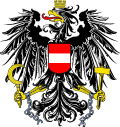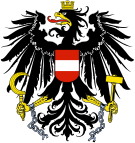- Chancellor of Austria
-
Chancellor of the
Republic of Austria
Coat of armsResidence Ballhausplatz 2 Appointer Heinz Fischer,
as President of AustriaTerm length No term limit Inaugural holder Karl Renner,
12 November 1918Formation First Austrian Republic,
12 November 1918Website www.bundeskanzler.at Austria 
This article is part of the series:
Politics and government of
AustriaConstitutionExecutive- President (List)
- Federal Government
- Chancellor (List)
- Vice-Chancellor
- Cabinet
Decentralized gov'tForeign policy
The Federal Chancellor (German: Bundeskanzler) is the head of government in Austria. Its deputy is the Vice-Chancellor. Before 1918, the equivalent office was the Minister-President of Austria. The Federal Chancellor (also known more simply as the Chancellor) is considered to be the most powerful political position in Austrian politics.
Contents
Appointment
The Chancellor is appointed by the President of Austria. The Chancellor assumes his office immediately after the appointment and is sworn in by the president.
In theory, the President can select anyone he wishes to be Chancellor. In practice, since the National Council has the right to pass a motion of no confidence in the government at any time, the Chancellor is always the leader of the majority party in the chamber or the biggest party in the governing coalition.
Role and powers
The Chancellor is "primus inter pares" ("first among equals") in the Austrian government. He chairs the meetings of the Austrian government but has no power to instruct other Federal Ministers. He is not the head of state, nor is he the commander in chief of the Austrian Armed Forces. Both roles are vested with the Federal President. The Chancellor cannot appoint nor dismiss other federal ministers. He can only recommend such an action to the Federal President, who may then appoint or dismiss a minister. However, it has become a very strong constitutional convention for the President to act on the Chancellor's advice. Furthermore the Chancellor normally also heads a federal ministry. Thus, although considered as the most powerful political position in Austria, he has a much weaker standing than the United States President or the Prime Minister of the United Kingdom.
The political power of the Chancellor mainly derives from his power in his political party, which he normally chairs, and can vary a lot depending on whether there is a coalition or a single-party cabinet. Normally the Chancellor is the leader of the biggest party in the Austrian parliament, however the Federal President is free to appoint any other person also. In 2000 the Federal president appointed Wolfgang Schüssel although his party then had only been 3rd in the previous elections.
List of Chancellors of Austria
Main article: List of Chancellors of AustriaSee also
- Politics of Austria
- List of Chancellors of Austria
- Vice-Chancellor of Austria
- President of Austria
- List of Federal Presidents of Austria
- Lists of incumbents
- List of Ministers-President of Austria
- List of Austrian Chancellors by Longevity
External links
Chancellors of Austria First Austrian Republic Karl Renner · Michael Mayr · Johann Schober · Walter Breisky · Johann Schober · Ignaz Seipel · Rudolf Ramek · Ignaz Seipel · Ernst Streeruwitz · Johann Schober · Carl Vaugoin · Otto Ender · Karl Buresch · Engelbert Dollfuss · Kurt Schuschnigg · Arthur Seyss-InquartSecond Austrian Republic European Council List of meetings · President · Party composition (1999 • 2000 • 2001 • 2002 • 2003 • 2004 (Jan–Apr) • 2004 (May–Dec) • 2005 • 2006 • 2007 • 2008 • 2009 • 2010 • 2011)  Van Rompuy (President) ·
Van Rompuy (President) ·
 Faymann ·
Faymann ·  Leterme ·
Leterme ·  Borisov ·
Borisov ·  Christofias ·
Christofias ·  Nečas ·
Nečas ·  Thorning-Schmidt ·
Thorning-Schmidt ·  Ansip ·
Ansip ·  Katainen ·
Katainen ·  Sarkozy ·
Sarkozy ·
 Merkel ·
Merkel ·  Papademos ·
Papademos ·  Orbán ·
Orbán ·  Kenny ·
Kenny ·  Monti ·
Monti ·  Dombrovskis ·
Dombrovskis ·  Grybauskaitė ·
Grybauskaitė ·  Juncker ·
Juncker ·  Gonzi ·
Gonzi ·
 Rutte ·
Rutte ·  Tusk ·
Tusk ·  Passos Coelho ·
Passos Coelho ·  Boc ·
Boc ·  Radičová ·
Radičová ·  Pahor ·
Pahor ·  Zapatero ·
Zapatero ·  Reinfeldt ·
Reinfeldt ·  Cameron ·
Cameron ·
 Barroso
Barroso
European Union Portal Heads of state and government of Europe Heads of state States recognised by the United NationsAlbania · Andorra · Armenia1 · Austria · Azerbaijan1 · Belarus · Belgium · Bosnia and Herzegovina · Bulgaria · Croatia · Cyprus1 · Czech Republic · Denmark · Estonia · Finland · France · Georgia1 · Germany · Greece · Hungary · Iceland · Ireland · Italy · Kazakhstan1 · Latvia · Liechtenstein · Lithuania · Luxembourg · Macedonia · Malta · Moldova · Monaco · Montenegro · Netherlands · Norway · Poland · Portugal · Romania · Russian Federation1 · San Marino · Serbia · Slovakia · Slovenia · Spain · Sweden · Switzerland · Turkey1 · Ukraine · United Kingdom · Vatican CityStates recognised by at least one United Nations memberStates not recognised by any United Nations membersHeads of government States recognised by the United NationsAlbania · Andorra · Armenia1 · Austria · Azerbaijan1 · Belarus · Belgium · Bosnia and Herzegovina · Bulgaria · Croatia · Cyprus1 · Czech Republic · Denmark · Estonia · Finland · France · Georgia1 · Germany · Greece · Hungary · Iceland · Ireland · Italy · Kazakhstan1 · Latvia · Liechtenstein · Lithuania · Luxembourg · Macedonia · Malta · Moldova · Monaco · Montenegro · Netherlands · Norway · Poland · Portugal · Romania · Russian Federation1 · San Marino · Serbia · Slovakia · Slovenia · Spain · Sweden · Switzerland · Turkey1 · Ukraine · United Kingdom · Vatican CityStates recognised by at least one United Nations memberStates not recognised by any United Nations membersNagorno-Karabakh1 · Transnistria1 Partially or entirely in Asia, depending on the definition of the border between Europe and Asia.Categories:- Chancellors of Austria
- Lists of office-holders by country
- Government of Austria
- Austria-related lists
- Living people
Wikimedia Foundation. 2010.


